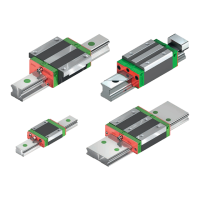20
Assembly
Assembly instructions
Linear Guideways
GW-04-0-EN-1910-MA
5.3 Protection of the mounting holes
To protect the block from soiling and to protect the dust protection sealing lips, the profile rails’ mounting holes must be
closed using cover caps (in the case of R-rails, fixing is carried out from above). The type of cover depends on the environ-
mental and operating conditions: plastic, steel or brass cover caps, or a cover strip, may be used. Plastic cover caps are
mounted as described in Section 5.3.1.2. Steel and brass cover caps are pressed in using an assembly tool as described in
Section 5.3.1.3. Cover strips are mounted as described in Section 5.3.2.
X Place the plastic cover cap centrally on the bore.
X Ensure parallelism between the top of the rail and the top of the cover cap.
X Place an eligible press-in block upright on the cap
X With a plastic hammer hit in the cover cap through a central blow to the press-in block.
X If the cap is not yet fully pressed in, repeat the procedure until the cap is flush with the rail top.
Fig. 5.15 Positioning of the plastic cover cap
Fig. 5.16 Pressing in of the plastic cover cap with the
help of a press-in block
Fig. 5.17 Fully assembled plastic cover cap
The plastic cover cap has been mounted.
Damage caused by cover caps that have been incorrectly pressed in!
Pressing in the cover caps can result in a burr or result in the cover caps being pressed in too deep. This can later result
in damage to the block and dust protection.
X Use an oil stone to remove any burrs that have occurred!
X Remove any cover caps that have been pressed in too deep and press in new cover caps!
ATTENTION!
5.3.1 Bolt caps
5.3.1.1 Requirements
The profile rails are mounted and fixed in accordance with the descriptions in Section 5.2.4/5.2.5.
The profile rails are free of dust and oil (see Section 7.1).
5.3.1.2 Mounting of plastic cover caps

